BOSE COMPANION 5 Schematic

Companion® 5 Multimedia
Speaker System
Theory of Operation
CONTENTS |
|
Product Description and Overview ................................................................................................ |
2 |
Power Supplies, Block Diagram ...................................................................................................... |
3 |
Power Supply, VSNUB ...................................................................................................................... |
4 |
Power Supply, VRAW......................................................................................................................... |
5 |
Power Supply 5V and 10V Regulators ............................................................................................ |
6 |
Power Supply 1.2V Regulator .......................................................................................................... |
7 |
Power Supply 3.3V Regulator .......................................................................................................... |
8 |
Sensor and Power Failure Detection ............................................................................................. |
9 |
USB Controller........................................................................................................................... |
10-11 |
Audio Interface ................................................................................................................................ |
12 |
Miscellaneous Control ................................................................................................................... |
13 |
Digital Signal Processor ................................................................................................................ |
14 |
Conversion and Ramp Generation ......................................................................................... |
15-16 |
Audio Path ................................................................................................................................. |
17-20 |
Power Amplifiers ............................................................................................................................. |
21 |
Headphone Amplifier ...................................................................................................................... |
22 |
Block Diagram ................................................................................................................................. |
23 |
1
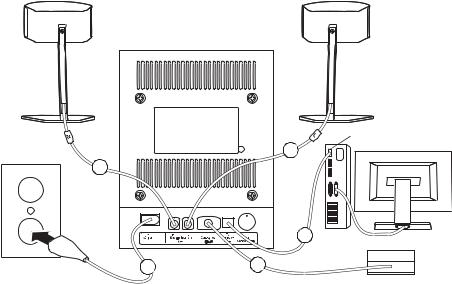
Companion 5 (Rising Star) Theory of Operation
F ran ç ais |
E spa ñol |
E nglis h |
Right (R) speaker |
Left (L) speaker |
Acoustimass rear panel
Computer USB
1
1
4
3 |
2 |
Control pod
Overview
Companion 5 is a multi-channel multimedia speaker system connecting to personal computers via a USB 2.0 interface. No sound card is required to enjoy 5.1-channel audio content from the host PC. The two speaker arrays combined with advanced audio processing algorithms provide a spacious presentation of stereo content and a compelling experience with multi-channel content. A control module brings the master volume control, simple touch mute control and jacks for an auxiliary analog stereo input and headphones.
The Companion 5 system consisting of the following major components:
1.Bass speaker enclosure with Woofer, DSP board, I/O board and system power supply.
2.Control Module with an 8-foot (2.4M) cable.
3.Two two-element speaker arrays with integrated cables, uniquely keyed and identified for left and right locations.
The Bass speaker enclosure is a ported MDF enclosure including the 5.25-inch dual voice-coil transducer and line power transformer. Both are installed inside the acoustic volume in such a manner that they are not serviceable. An electronics enclosure is provided at the back of the MDF enclosure. The heat sink assembly that includes the DSP/Power Amplifier/Power Supply Printed Circuit Assembly, aluminum heat sink, thermal compound, thermal interface material, and clamping bracket are screwed directly to the back wall of the acoustic enclosure. Internal cables connect the DSP/PA/PS assembly to the transformer secondary and the I/O Printed Circuit Assembly that is mounted to the plastic rear cover of the speaker.
The control module is not serviceable. Only the interface requirements to the Bass module electronics will be discussed in this document. The speaker arrays are mounted on removable speaker stands that are engineered to position the speakers at the correct height and angle on either side of a computer monitor. The transducers contained in the speaker enclosures may be replaced from the front of the enclosure by removing the metal grill. The grill should not be re-used once removed due to deformation during the removal process. The integrated cable is not removable. The balance of this document will concentrate on the electronic assemblies present in the bass
module.
2
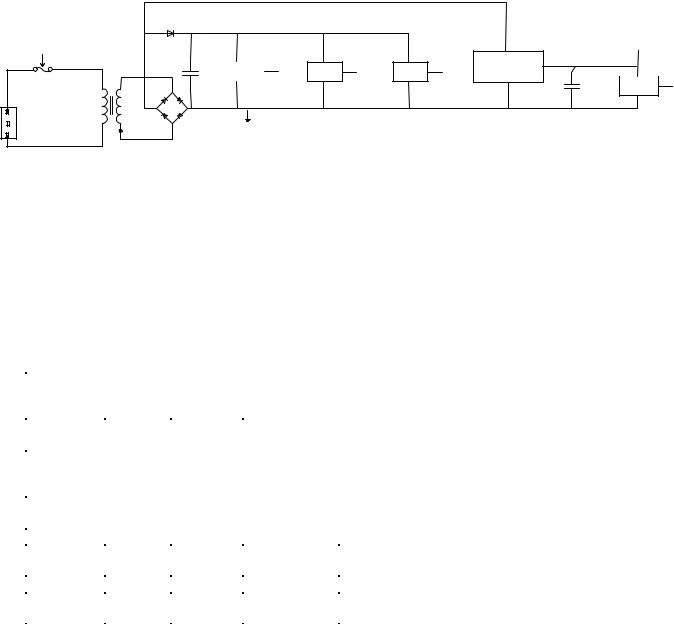
Power Supplies
VSNUB
VRAW
|
3.3V |
|
10V |
|
1.2V |
Q10 |
|
|
U902, Q9031 |
U20 |
U50, U51 |
Bose Brand FET |
|
||||
Reg |
|
Reg |
|
Reg |
|
Quasi-Regulator |
|
5V |
|
|
|
|
|
|
U11 |
||
|
|
|
|
|
|
|
||
Reg
Power Supply Block Diagram
Bass module rectifies un-regulated power VSNUB from the secondary of the line power transformer. VSNUB is, in turn, converted to the various other potentials required by the system. Nominally 26VDC, this voltage varies with load and line levels, but is limited to 31.5V maximum(assuming line voltage of 140V AC). This voltage is present whenever the bass module is plugged into the wall. All the voltage level source are listed in following table:
Node |
Output |
Type |
Input from |
Outputs to |
Name |
Voltage |
|
|
|
|
nominal |
|
|
|
Vsnub |
+26 |
Full wave |
transformer |
Vraw |
|
|
rectifier |
secondary |
|
Vraw |
+14 (no |
pre- |
VSNUB |
Power Amplifiers, +5V, VRAWSEN. |
|
load) |
regulator |
|
|
|
|
output |
|
|
+10V |
+10 |
linear |
VSNUB |
Headphone power amplifiers, control module |
|
|
|
|
green LED. |
+5V |
+5 |
linear |
Vraw |
CODEC Analog power supply |
+3.3V |
+3.3 |
switching |
VSNUB |
DSP I/O power supply, digital supply for USB |
|
|
|
|
controller, CODEC, EEROM. |
+1.2V |
+1.2 |
switching |
VSNUB |
DSP core power supply. |
SENSOR |
+3.0 |
series |
+3.3 |
Switch able supply for control module touch |
|
|
switch |
|
sensor, control module red LED |
3
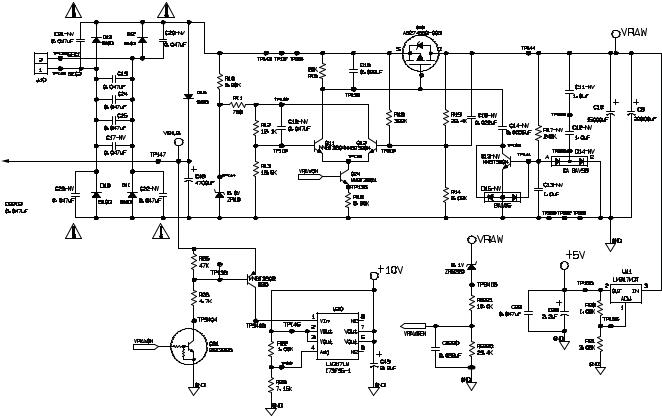
Power Supply VSNUB
From
Transformer
To 3.3 V
Regulator
VSNUB
VSNUB is formed by rectifying the transformer secondary potential via power rectifiers D10-D13. An additional rectifier, D16 prevents discharge of the filter capacitor, C48 through the FET switch, Q10, whenever this switch is on. For operating conditions other than extremely low line potential, this permits the peak potential at C48 to track closely to the peak secondary potential. This is substantially higher than the peak potential of the quasiregulated Vraw supply discussed below.
VSNUB also serves as a clamping potential into which some of the energy stored in the leakage reactance of the mains transformer is discharged when Q10 is switched off. This additionally energy can cause the peak potential for V-UNREG to actually be greater in magnitude than the peak potential of the transformer secondary when Vraw current drain is large. VSNUB can range from 20 to 40 volts, depending on input voltage and Vraw loading.
4
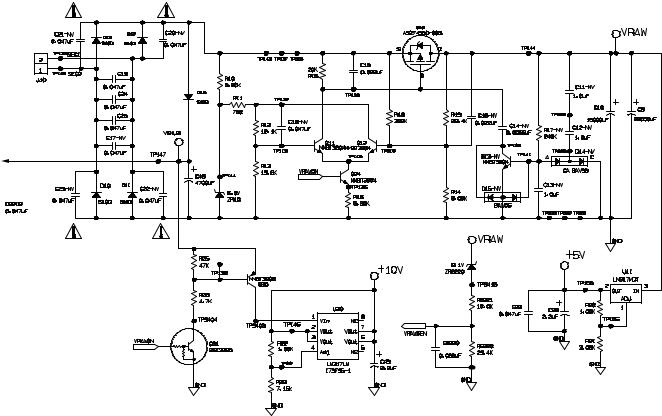
Power Supply VRAW
From
Transformer
To 3.3 V
Regulator
VRAW
Vraw provided power to the Audio Power Amplifiers, U150, U150, U350, and the +5V regulator. Its potential is monitored by the DSP, U7000, via the circuit associated with VRAWSEN. When active the potential can vary from 12 vdc to 14.0 vdc. The circuit controlling the FET switch, Q10, is configured to force commutate (turn off) the switch whenever the potential of the filter capacitor, either C9 or C10, exceeds the target potential of approximately 13 volts. The nature of the circuit causes Q10 to turn off during high peak currents. These high peak currents cause a voltage drop on C9’s (C10’s) internal equivalent series resistance (ESR) which, in turn, causes a drop in the sensed output potential as soon as the switch, Q10 is turned off. In order to prevent the circuit to immediately turn the switch back on, a fixed voltage hysteresis is applied by the control circuit to lower the turnon threshold of the circuit by 200 to 300 millivolts.
R10 and ZR10 form a 6.0V reference potential for the error amplifier formed by Q11, Q12. R11, R12, and R13 scale this reference voltage to an appropriate potential to permit start-up of the circuit. R11 doubles as the feedback resistor that sets the hysteresis mentioned above. R18 and R19 are essentially in parallel when Q10 is on, so R18, R19, and R14 set a relatively constant turn-off potential. When Q10 is off, R18 depresses the turn-on threshold of the circuit proportional to the open-circuit potential of the transformer secondary. This is in addition to the hysteresis provided by R11 and serves to prevent Q10 from turning on during the highest potentials of the input mains, as this is when the peak charging currents would be the largest.
Q24 and R16 serve as the enable input and current sink for the error amplifier. Maintaining a constant potential across R16, causes a constant potential to be applied Gate to Source of Q1 when Q10 is on. C15 controls the switching speed of Q10, which improves audible and electrical noise characteristics of circuit. Q13 and the additional components associated with Q13 provide additional shaping of the switching characteristics of Q10 when little power is consumed from Vraw.
5

Power Supply 5V and 10V Regulators
From
Transformer
To 3.3 V
Regulator
5V
The only internal power requirement for 5 volts are the CODEC, U4000, power supply and the current source for the ramp circuit formed by Q6201 and R6207. The source for the +5V linear regulator, U11, is Vraw. +5V is provided only when Vraw is enabled.
10V
This potential is used to power the headphone amplifier and signal that the system is not in stand-by operation. When installed on the I/O assembly, this potential will drive the primary circuit TRAIC. The GREEN LED on the control module is driven by this potential. Q30, Q31 and associated components for an enable circuit for the linear regulator U20. These components permit U20 to be disconnected from Vsnub during stand-by operation, thus avoiding the quiescent dissipation of U20 during these conditions.
6
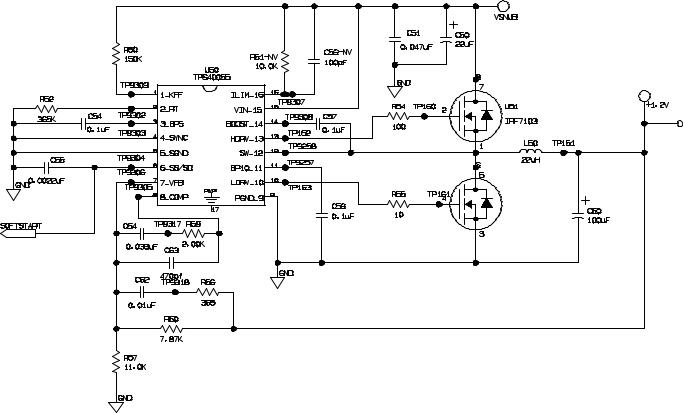
Power Supply 1.2V Regulator
1.2V
The processing core of the DSP is the sole consumer of the 1.2 volt power supply. Its relatively high current consumption requires efficient power conversion. The Texas Instruments TPS40055, U50, provides the PWM control functions for a synchronous-rectifier power circuit. U51 is a dual N-channel FET used as switch transistor and synchronous rectifier for the buck regulator circuit. Inductor L50 and filter capacitor C60 form the filter for the +1.2V supply. R57 and R60 establish the DC operating voltage for the output. R56, R59, C62, C63 and C64 provide the compensation for the feedback path.
C59 filters the 10 volt reference internal to U50 which is used to control the switching of the transistor drive signals. C57 provides the boot-strap (boost) potential to drive the high-side switch. C54 filters the 5 volt reference also generated internally to U50.
R52 sets the operating frequency of the PWM circuit of approximately 100kHz. Resistor R52 provides a reference to the input voltage which is used by U20 provide feed-forward input voltage compensation. C55 shapes the soft-start characteristics of the regulator.
7
